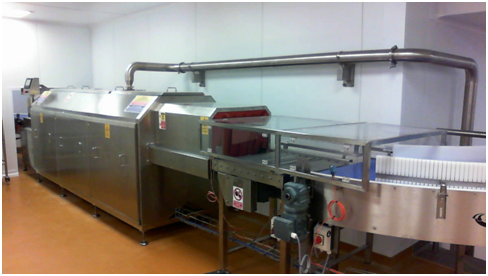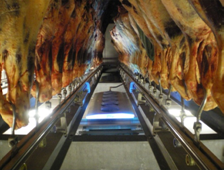UV Surface Treatment
“UV treatment helps to reduce customer complaints and the associated reputational damage.”
With the growing negative public reaction over chemicals added to food products, Ultraviolet light (UV light) holds considerable promise in food processing as an alternative to traditional thermal processing. It is a non-thermal processing technology, generally used for decontamination and to extend the shelf life of food products.
What is UV?
UV forms part of the electromagnetic spectrum and the UV wavelength range is from about 10 to 400 nm, placing it between X-rays and the visible part of the spectrum.

Outside of the field of water treatment, UV is often referred to as a surface treatment. Specifically with reference to surface treatment, it is important to realize that UV is strongly absorbed by most materials and cannot penetrate beyond the surface layers of solid objects. In such instances for both abiotic materials and many types of foods, it is only microorganisms that are present at the surface that one may ultimately hope to inactivate.
“Surface topography strongly influences the efficacy of UV surface treatment. Crevices, and similar features, of dimensions comparable to the size of microorganisms (i.e., a few microns) may shield microorganisms from potentially lethal UV rays and enable them to survive. This was cited in recent work as the reason why the UV treatment of fish fillets from a smooth-fleshed species was more effective than that of a rough-fleshed one.
Equipment Selection criteria for UV Surface Treatment:
1. Target microorganism(s)
2. Desired log reduction
3. Dimensions of items or size of area to be disinfected
4. Speed requirements
5. Process integrations
6. Space limitations

UV disinfection applications for food industry
1. Food Decontamination: UV treatment can be done to reduce the contamination of food surfaces. This will improve the quality and extend the shelf life of the food product.
2. Packaging Disinfection: To avoid recontamination of food product after packaging, food business operators (FBOs) can use UV treatment to disinfect packaging material. Disinfection of packaging material will help to ensure that safe food is served to the consumers.
3. Disinfection of Equipment: FBOs can use UV lamps or any other UV equipment to disinfect equipment and reduce contamination.
For instance, on surfaces such as conveyor belts, particularly in the meat and meat processing areas, UV light can be used to provide continuous decontamination in the form of a module designed to expose the belt to UV as it passes. The module is completely watertight and can be incorporated into CIP best practices. The intense germicidal action of UV light acts on microorganisms on the belt surface, rendering them inactive. This treatment can reduce the number of complete wash-downs required during processing, thereby saving resources such as water and energy costs.
4. Disinfection of Process Rooms: An assessment of the possible sources of mould spores in the processing environment usually indicates a build-up of material in the air supply. In order to treat the incoming air, a simple, economical and effective step is the installation of UV light in the air duct. Other than this, various fixed mount and mobile UV solutions are available for disinfection of air and surfaces within process rooms.

